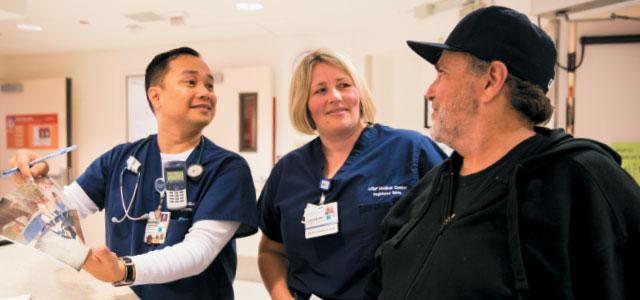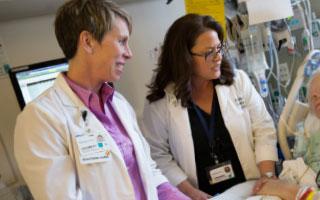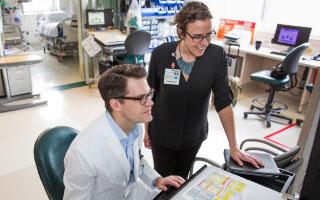
Jim Banta (right) discusses his time as a patient with UCSF Medical Center nurses Jeselle Abilla and Kristina Haas (photo by Elisabeth Fall).
More Common and More Harmful Than Once Believed, Delirium Takes Center Stage
Fifteen years ago, when construction worker Jim Banta was hospitalized with a severe gastrointestinal bleed, doctors discovered he had hepatitis C and end-stage renal disease. Over the next nine years, he was hospitalized multiple times and experienced his first episodes of hospital-induced delirium.
“I remember thinking all the nurses were on a carousel, laughing at me, pointing their fingers,” he says.
Then, in October 2009, at age 55, Banta lapsed into a coma and arrived by ambulance at San Francisco General Hospital. Doctors there stabilized Banta, then transferred him to UCSF Medical Center at Parnassus, where he spent the next five and a half weeks moving between an acute care floor and the ICU while awaiting a liver transplant.
“I remember telling my brother and sons that some of the orderlies were going to kill me,” says Banta. “I thought all kinds of crazy stuff. You’re in bed 24/7, you get very little sleep, and I had a lot of invasive stuff being done that I didn’t understand. It might have seemed real small to my family members, but not being able to express it was horrifying.”
Underestimating Delirium’s Clinical and Economic Impact
Banta’s experience with delirium is more common and has longer-lasting effects than was once believed. Over the last couple of decades, a proliferating number of studies on the incidence and impact of delirium are causing the health care community to sit up and take notice.
Hildy Schell-Chaple (MS ’93, PhD candidate ’16) is a clinical nurse specialist who has worked in the ICU at UCSF Medical Center for 27 years. Part of an interdisciplinary group leading UCSF efforts to better prevent and manage delirium in the ICU, Schell-Chaple – who is also associate faculty at UCSF School of Nursing, says, “It used to be that we associated delirium only with the hyperactive form, but one important finding of the studies is that hypoactive delirium – where patients are inattentive or unresponsive – is more common and underdiagnosed.”
That recognition has helped change understanding of the condition’s prevalence.
 Jacqueline Leung and J. Matthew Aldrich UCSF anesthesiologist Jacqueline Leung, who heads the Perioperative Medicine Research Group, has found that in patients over age 65, postoperative delirium can occur anywhere between 10 percent and 60 percent of the time, depending on risk factors. Critical care nurse specialist Brenda Pun – whose research at Vanderbilt University with critical care physician Wesley Ely is widely recognized as leading the field – says that in the general medical ICU setting, “Delirium has been diagnosed in 60 to 75 percent of patients receiving mechanical ventilation.”
Jacqueline Leung and J. Matthew Aldrich UCSF anesthesiologist Jacqueline Leung, who heads the Perioperative Medicine Research Group, has found that in patients over age 65, postoperative delirium can occur anywhere between 10 percent and 60 percent of the time, depending on risk factors. Critical care nurse specialist Brenda Pun – whose research at Vanderbilt University with critical care physician Wesley Ely is widely recognized as leading the field – says that in the general medical ICU setting, “Delirium has been diagnosed in 60 to 75 percent of patients receiving mechanical ventilation.”
If – as long believed – delirium were merely a temporary condition, those numbers might be less concerning, but a growing number of studies have shown lasting effects, including ongoing cognitive decline associated with a diminished quality of life and long-term mortality. Moreover, the longer a patient experiences delirium in the hospital, the worse the cognitive decline.
Equally noteworthy, long-term cognitive impairment is not just limited to older patients with delirium. “Approximately one-third of patients under the age of 50 will have cognitive dysfunction at one year similar to moderate traumatic brain injury,” says critical care specialist J. Matthew Aldrich, director of adult critical care medicine at UCSF Medical Center.
Finally, in a health care system intensely focused on high-value care, delirium is associated with longer hospital stays and higher costs. Leung’s studies have shown that patients over age 65 with postoperative delirium are three times more likely than those without delirium to be discharged to either a skilled nursing facility, another hospital or a nursing home.
Managing Delirium Demands Expert Nursing
As people have begun to better understand the human and financial costs of delirium, attention has turned to preventing and effectively managing it, says Schell-Chaple.
This begins with educating doctors, nurses, pharmacists, physical therapists, occupational therapists, speech therapists and patients and families about the options available. Advanced practice and bedside nurses are often at the center of these efforts, because they are the frontline clinicians doing formal screening and ad hoc assessments.
“In our ICU group, we have some real nurse experts in the field, like [Schell-Chaple] and [UCSF School of Nursing Faculty Emerita] Kathleen Puntillo,” says Aldrich.
That expertise is essential, because changing people’s mind-set and practice is a considerable challenge that begins with raising awareness.
 Charlotte Garwood and Hildy Schell-Chaple attend to a patient. “When I began nursing, no one even used the term delirium, and many nurses and physicians still think only about confusion and agitation,” says clinical nurse specialist Charlotte Garwood (MS ’10), who worked closely with Schell-Chaple in the UCSF ICU for many years and whose master’s work included a project on ICU delirium.
Charlotte Garwood and Hildy Schell-Chaple attend to a patient. “When I began nursing, no one even used the term delirium, and many nurses and physicians still think only about confusion and agitation,” says clinical nurse specialist Charlotte Garwood (MS ’10), who worked closely with Schell-Chaple in the UCSF ICU for many years and whose master’s work included a project on ICU delirium.
“If you’re not doing standardized screening, delirium could be characterized as something else,” says clinical nurse specialist (CNS) Melissa Lee (MS ’03). “That’s why education, standardized tools and all clinicians speaking the same language is so important and the only way to get to effective prevention and management measures.”
In 2010, an interdisciplinary team from the ICU concluded that many clinicians still did not understand the condition, so they organized a symposium aimed at updating the current knowledge base. Speakers included Pun, UCSF neurohospitalist S. Andrew Josephson, UCSF ICU pharmacist Ashley Thompson and UCSF physical therapist Heidi Engel.
A couple of hundred people attended, and Garwood says, “When Brenda Pun spoke about the long-term effects, it really inspired many of us and validated our concerns about our patients. People became aware that some patients might never be able to return to their job, that 20 to 30 percent of patients will still have cognitive challenges at 12 months post ICU stay.”
The symposium was part of a confluence of events that spurred many across UCSF to step up their efforts to better prevent and manage delirium. Pharmacy residents ran a number of small-scale studies aimed at addressing the roles they could play in delirium prevention. Nurses – some through an evidence-based fellowship program at the medical center – looked at a number of potential care pathways. One study led to the creation of a “sleep bundle” aimed at maintaining patients’ normal sleep patterns.
“The study earned a scientific merit award, and after, we definitely saw a change in the prevalence of delirium,” says Schell-Chaple.
The ICU’s ABCDEF Bundle
In fact, in critical care, efforts across the country have had a special urgency, because it’s a place where delirium occurs more often than anywhere else in the acute care setting, according to Pun. One of the most important insights of the research she and Ely have conducted was that delirium does not occur in a vacuum.
“When we think of managing critically ill patients, there are three major issues, regardless of diagnosis: pain, agitation and delirium,” she says. “They are interconnected to one another, sometimes interdependent, so if we assess and manage them in silos, we will miss the opportunity to see that interaction and may mismanage all three.”
 That’s why it was so important that in 2013 the Society of Critical Care Medicine published “Clinical Practice Guidelines for the Management of Pain, Agitation, and Delirium in Adult Patients in the Intensive Care Unit,” which recommend that routine assessment of these three symptoms using validated tools provides the foundation for patient management. One way to implement these guidelines into bedside practice and allow the staff to see the big picture while executing the specific interventions is the ABCDEF bundle. The bundle is a group of evidence-based measures aimed at standardizing communication, improving interdisciplinary patient care, reducing mortality and improving long-term cognitive and functional outcomes. (In 2013, the Society of Critical Care Medicine also began its ICU Liberation Campaign, aimed at ensuring that ICUs around the country are implementing the ABCDEF bundle.)
That’s why it was so important that in 2013 the Society of Critical Care Medicine published “Clinical Practice Guidelines for the Management of Pain, Agitation, and Delirium in Adult Patients in the Intensive Care Unit,” which recommend that routine assessment of these three symptoms using validated tools provides the foundation for patient management. One way to implement these guidelines into bedside practice and allow the staff to see the big picture while executing the specific interventions is the ABCDEF bundle. The bundle is a group of evidence-based measures aimed at standardizing communication, improving interdisciplinary patient care, reducing mortality and improving long-term cognitive and functional outcomes. (In 2013, the Society of Critical Care Medicine also began its ICU Liberation Campaign, aimed at ensuring that ICUs around the country are implementing the ABCDEF bundle.)
The letters, says Pun, stand for:
- Assess, prevent and manage pain
- Both Spontaneous Awakening Trials and Spontaneous Breathing Trials
- Spontaneous Awakening Trials are a strategy where, each day as appropriate, clinicians stop patients’ use of sedatives and, if needed, restart them at half the previous dose and titrate as needed. Among other things, the period without sedatives enables clinicians to better assess for various clinical concerns, including delirium, and get patients up and moving as early as possible (see “Early mobility and exercise” below).
- Spontaneous Breathing Trials are a technique for weaning patients from their mechanical ventilator.
- Choice of analgesia (pain medication) and sedation
- Delirium: assess, prevent and manage
- In the UCSF ICU, protocols direct nurses to screen patients multiple times during a shift – not just for delirium, but also for pain, agitation and sedation.
- Early mobility and exercise
- “Early mobility [with either the nurse or the physical therapist] is particularly important because at this point, it is the only tactic that research has shown clearly reduces the duration of delirium,” says Schell-Chaple.
- Family engagement and empowerment
- “Reorientation is essential, and it’s important to make families aware and part of that process,” says Garwood. “Whether it’s making sure patients have their eyeglasses or hearing aids, keeping curtains open during the day or keeping people informed about how things are going with the grandkids, it’s huge that patients have some sort of anchor to what’s real.… We also have a diary program, where family members and staff keep notes about what’s happening to the patient.”
Nursing Drives a Common Language for Team-Based Care
“We realized early on that nurses are the linchpin, because everything starts with them completing screening, performing spontaneous awakening trials and administering medications for pain and agitation,” says UCSF ICU pharmacist Kendall Gross, an early member of the UCSF ICU’s delirium team.
“It’s very important to have skilled nurses who understand how to do the screening and who help create and enforce a common language that helps all clinicians interact more effectively as they work through the bundle,” says Pun.
 J. Matthew Aldrich with Kendall Gross in the ICU Addressing pain is often the first priority. “Historically, if we saw a patient agitated who couldn’t seem to settle down, they would get [benzodiazepines] to calm down,” says Thompson. “Today, we try to determine if that patient is in pain, because we know untreated pain leads to agitation and that sedation isn’t necessarily benign.” She says the research suggests that benzodiazepines should be avoided or minimized as much as possible.
J. Matthew Aldrich with Kendall Gross in the ICU Addressing pain is often the first priority. “Historically, if we saw a patient agitated who couldn’t seem to settle down, they would get [benzodiazepines] to calm down,” says Thompson. “Today, we try to determine if that patient is in pain, because we know untreated pain leads to agitation and that sedation isn’t necessarily benign.” She says the research suggests that benzodiazepines should be avoided or minimized as much as possible.
Yet pain medication isn’t benign either, says Leung, who is leading a National Institutes of Health (NIH)-funded clinical trial to determine if intensive pain management using a non-narcotic adjuvant will decrease the incidence of postoperative delirium and cognitive dysfunction.
“We need to work with surgeons to do risk stratification and consider alternative pain relief modalities, like nerve blocks and adjunctive nonopioid medications with analgesic effects,” says Leung. Clinicians at UCSF are increasingly focused on multimodal approaches to pain management – alternative medications, as well as nonpharmacological techniques.
“The key is a holistic approach and systematically evaluating deliriogenic medications,” says Gross. “Aside from benzodiazepines, we suspect that corticosteroids can also be a factor.” There is ongoing research to validate these and other potential factors.
In addition, the UCSF critical care team has been refining its interdisciplinary rounds to ensure delirium prevention remains on everyone’s radar. The team is working with Johns Hopkins University and the Gordon and Betty Moore Foundation on Project Emerge. One component of this project is the introduction of a tablet-based application with a color-coded wheel that addresses seven elements of harm reduction, including delirium prevention. During rounds, the app enables teams to quickly see what has been done to prevent harm and whether they are following protocols.
“It’s a dynamic checklist that we’ll discuss at the end of the nurse’s and resident’s presentation, before we make a detailed plan for the day,” says Aldrich. “The idea is to build a rounds structure that makes it mandatory and essential that you discuss all these elements, using the same language across disciplines, and then build in care pathways that become routine.”
Implementation
“But practice change doesn’t happen overnight, and this is still a work in progress,” says Schell-Chaple. “It’s getting more ingrained, but as the literature changes, we have to keep changing our processes.”
“The challenge really is implementation,” says Aldrich. “Getting [the different disciplines] all on the same page. We’re also working to overcome a sense of learned helplessness around delirium. Until recently, we didn’t fully understand that there are interventions that can have a real impact on prevention and treatment.”
That’s why over the summer of 2015, critical care teams created a new template for rounds in the ICU, with clear instructions to residents and nurse practitioners about what to collect and how to present. Delirium was one of the main foci.
And, of course, it can’t stop in the ICU, not with the current intense focus on care coordination. “ICU discharge handoffs should include clear communication regarding whether delirium was present in the ICU and how it was managed,” says Pun. “I see this work best in places where the non-ICU settings already have delirium assessment and management plans in place. It works best when the whole hospital is speaking the same delirium language.”
Spreading Awareness
UCSF is one such place, with awareness and delirium prevention efforts spreading throughout the hospital.
For example, since November 2013 an interdisciplinary team led by neurohospitalist Vanja Douglas began piloting its own effort to better prevent and manage delirium in the medical center’s neurology unit.
 Kendall Gross and Ashley Thompson Neurology’s program has nurses assessing anyone over 50 with a tool that helps predict a patient’s risk of delirium. Douglas and UCSF colleagues developed the tool, which takes two minutes to administer. If they determine a patient is at risk – or if the patient develops signs of delirium based on another screen nurses administer every shift – it triggers an individualized care plan that typically includes many of the factors present in other plans, such as minimizing nighttime disruptions, ensuring early and frequent daytime mobility, minimizing the use of narcotics and frequent reorientation.
Kendall Gross and Ashley Thompson Neurology’s program has nurses assessing anyone over 50 with a tool that helps predict a patient’s risk of delirium. Douglas and UCSF colleagues developed the tool, which takes two minutes to administer. If they determine a patient is at risk – or if the patient develops signs of delirium based on another screen nurses administer every shift – it triggers an individualized care plan that typically includes many of the factors present in other plans, such as minimizing nighttime disruptions, ensuring early and frequent daytime mobility, minimizing the use of narcotics and frequent reorientation.
Similarly, Leung’s long interest in improving postsurgical outcomes for older patients – a critical concern in a country with a rapidly aging population – grew into a clinical study that looks at whether screening older noncardiac surgical patients for delirium risk factors, communicating the risk and then screening regularly could help prevent and manage the condition. The University of California Health System’s Center for Health Quality and Innovation provided funding for the work, which began on one floor of UCSF Medical Center at Parnassus and is now in place in many of the adult care units across UCSF.
Similar to the neurology effort, nurses identify risks for postoperative delirium with an easy-to-administer baseline cognitive assessment. They communicate the risks to clinical staff and families and may adapt nursing protocols accordingly. For example, they might ensure patient rooms are closer to the central nursing station or that a sitter or family member stays with the patient. Then nurses continue to screen for delirium on every shift, and if the condition occurs, they make sure the proper care pathways are in place and coordinate the appropriate consults.
CNS Lee plays an essential role as one of the nurse champions for the project. “I ensure nurses have the knowledge and the right tools to prevent and manage delirium – and I support them at the bedside at the point of care,” she says.
She is also instrumental in spreading awareness throughout the hospital and has been the primary educator as the project has been rolled out to new care areas.
That includes a pilot Acute Care for Elders (ACE) program at Parnassus. ACE programs aim to optimize the care of hospitalized older adults, with a particular focus on maintaining and improving physical and cognitive function. Such programs already exist at San Francisco General Hospital and the San Francisco VA Health Care System. Geriatric nurse practitioner Julie Carpenter (MS ’14) is coordinating the effort at Parnassus with a close eye on delirium.
In the program, nursing teams have a physician-initiated order set for patients over 65 who meet certain criteria. That order set includes screening for delirium, and since that is something new to the nurses involved in the project, Carpenter provides the necessary education and support. Again here, the care pathways are rooted in the ABCDEF bundle.
“I think it’s exciting that as an organization, all of these different groups are starting to talk about this, and even in my six years [as a nurse at the medical center], I definitely see a shift in thinking about delirium,” says Carpenter.
The Future
 Aldrich agrees and says, “I’m very optimistic that our new awareness and approach to delirium will have a meaningful impact on the lives of our patients and their families.”
Aldrich agrees and says, “I’m very optimistic that our new awareness and approach to delirium will have a meaningful impact on the lives of our patients and their families.”
More change is still on the horizon, as most agree the condition remains ripe for further validation of the existing bundle, for research on potential medications and for more effective prevention techniques. Some studies are beginning to show that 30 percent of delirium episodes are preventable with nonpharmacological interventions, again largely the province of nurses.
Garwood is happy to see that the awareness has spread to patients and families as well, in part because UCSF’s ICU received grant funding to create an Adult Critical Care Patient and Family Advisory Council. Banta is a member, and he also visits patients regularly. “I love doing it,” he says. “And I know it makes a difference.”
He also knows that nursing staff in the ICU played an instrumental role in easing his terror. “One ICU nurse, I wish I could remember names, would always tell me that all the other people who came in the room were her friends,” says Banta. “It was a great tactic because it made me begin to look at the people there differently.”



